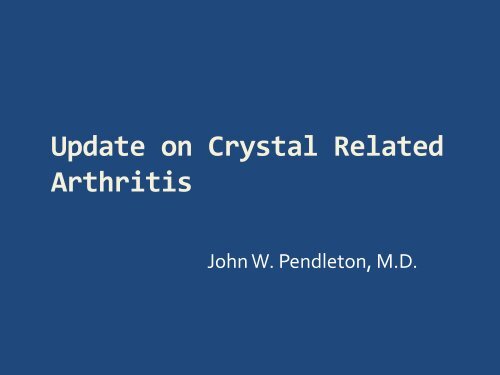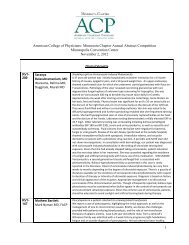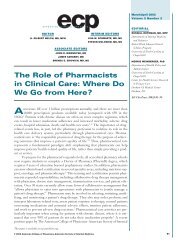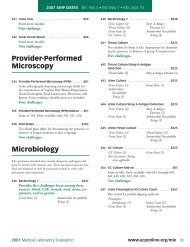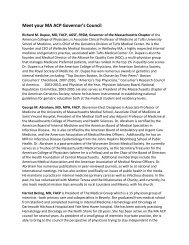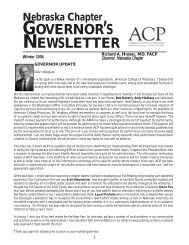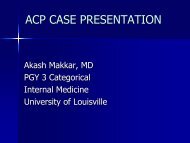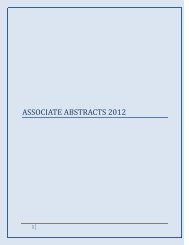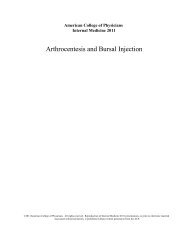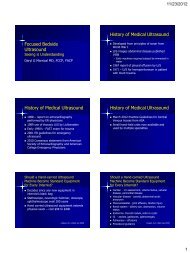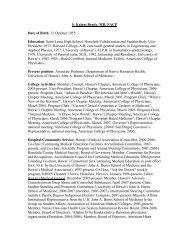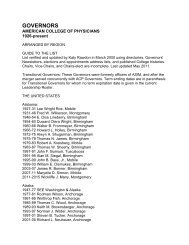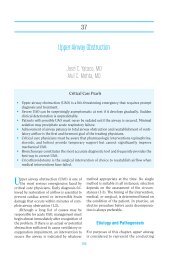Crystal Induced Arthropathy
Crystal Induced Arthropathy
Crystal Induced Arthropathy
Create successful ePaper yourself
Turn your PDF publications into a flip-book with our unique Google optimized e-Paper software.
Update on <strong>Crystal</strong> Related<br />
Arthritis<br />
John W. Pendleton, M.D.
What’s New in <strong>Crystal</strong> Related<br />
Arthritis?<br />
Gout<br />
Diagnosis<br />
Unique characteristics of gout in older patients<br />
The role of hyperuricemia in related conditions and<br />
should it be treated<br />
Treatment of gout<br />
Calcium Pyrophospahte Dihydrate Deposition<br />
Disease<br />
Diagnosis<br />
Multiple presentations and evaluation<br />
Treatment
Gout<br />
A disorder related to monosodium urate crystal<br />
(MSU) deposition in tissues and characterized by<br />
Hyperuricemia –At levels ≥ 6.8 –7 mg./dl., MSU is<br />
supersaturated in plasma and begins to deposit in<br />
synovium and soft tissues<br />
Arthritis –acute and chronic<br />
Tophi<br />
Potential for renal dysfunction<br />
Nephrolithiasis
Gout<br />
BUT ‐ Eighty percent of people with uric acid<br />
over 7 mg/dl do not develop gout.<br />
Risk of gout related to level of uric acid in 2046<br />
men followed for 14.9 years<br />
UA level 5 year incidence of gout *<br />
7 –7.9 2%<br />
8 –8.9 4.1%<br />
9 – 9.9 29.8%<br />
> 10 30.5%<br />
Hyperuricemia appears to lead to similar risk of<br />
gout in women as in men<br />
Amer J Med 1987;82:421-26
Gout ‐ Diagnosis<br />
Typically acute monoarthritis<br />
Serum uric acid may be misleading –<br />
Normal in up to 40% at time of attack<br />
Frequently elevated without symptoms or with<br />
musculoskeletal symptoms unrelated to gout<br />
Best diagnostic clues<br />
Sensitivity Specificity*<br />
Podagra 96 97<br />
Tophi 30 99<br />
Urate crystals in<br />
Synovial fluid 84 100<br />
Arthrocentesis ‐ best way to confirm<br />
Negatively birefringent crystals<br />
YUPA ‐ yellow urate parallel axis<br />
*Adapted from Am Fam Phy 2007;2007:801
Acute Podagra
Compensated polarized microscopy - YUPA
Gout in the Older Patient<br />
Incidence is increasing<br />
65 –74 ≥ 75<br />
1990 21 to 24/1000 21/1000<br />
1999 31/1000 41/1000<br />
Women are 40 % of new cases<br />
Prevalence after age 80 –M 9%, W 6%<br />
Unusual joints –DIP, PIP, shoulder<br />
Presentation may be atypical<br />
Polyarticular, more chronic joint problems<br />
Develop tophi more quickly, unusual locations<br />
J Rheum 2004;31:1582-7
Gout in the Older Patient<br />
Incidence is increasing<br />
65 –74 ≥ 75<br />
1990 21 to 24/1000 21/1000<br />
1999 31/1000 41/1000<br />
Presentation may be atypical<br />
Polyarticular, more chronic joint problems<br />
Develop tophi more quickly, in unusual locations<br />
Women are 40 % of new cases<br />
Prevalence after age 80 –M 9%, W 6%<br />
Unusual joints –DIP, PIP, shoulder<br />
J Rheum 2004;31:1582-7
Hyperuricemia & Related<br />
Conditions<br />
Hypertension<br />
U.A. increased in 25‐60% of adults, 90% of adolescents<br />
Myocardial Infarction<br />
MRFIT ‐ OR 1.1 ( 1.08 –1.15) p< .001, ↑ of 1 mg/dl of uric<br />
acid, ↑ risk of MI by 4%<br />
Rotterdam study ‐ ↑ MI & CVA<br />
Metabolic Syndrome<br />
insulin inhibits uric acid excretion<br />
serum uric acid is strong predictor of development, thus<br />
hyperuricemia may be an early marker
Gout & Related Conditions<br />
Hypertension<br />
NHANES III – 69% w/ gout vs. 30% control<br />
Myocardial Infarction<br />
MRFIT –OR* 1.26 ( 1.14 –1.40) p < .001<br />
Similar data from HPFS – fatal & non‐fatal<br />
Metabolic Syndrome<br />
NHANES III –63% vs 25%<br />
first gout attack precedes features of metabolic syndrome<br />
*OR – odds ratio
Gout & Related Conditions<br />
Obesity<br />
HPFS – prevalence of gout ↑ with ↑ BMI<br />
Type 2 Diabetes Mellitus<br />
MRFIT –RR of developing 1.34 (1.09‐1.64)<br />
NHANES III –OR 2.55 of having FBS > 110
Hyperuricemia – A Cause of or<br />
Marker for These Diseases<br />
Is hyperuricemia an independent risk factor and<br />
should it be treated as such?<br />
Evidence for causal relationship<br />
Uric acid causes endothelial dysfunction in animal models<br />
<strong>Induced</strong> hyperuricemia in mice leads to arteriolar disease<br />
and hypertension<br />
Degree of hypertension related to degree of<br />
hyperuricemia<br />
Can be reversed with uric acid lowering meds
Hyperuricemia – Cause or<br />
Marker<br />
Problems with evidence of causal relationship<br />
Human data is essentially all observational<br />
No RCT trials that demonstrate lowering uric acid<br />
impacts on the incidence or outcome of any of these<br />
disorders<br />
The adverse drug events associated with the uric acid<br />
lowering drugs require clear indication prior to using
So What Should We Do?<br />
Should we treat asymptomatic hyperuricemia<br />
To prevent gout ‐ Not at this time<br />
To impact related diseases –Not at this time<br />
But in a patient with asymptomatic<br />
hyperuricemia<br />
Look for remedial causes of the hyperuricemia –<br />
obesity, alcohol, medications<br />
Look for evidence of risk factors of or presence of<br />
related disorders that need to be addressed<br />
In patients with gout and related disorder<br />
• Early and effective uric acid lowering treatment
Gout – Treatment of Acute Attack<br />
Educational points for patients –<br />
The earlier an attack is treated, the more quickly it<br />
responds<br />
If on uric acid lowering agent and an acute attack occurs,<br />
continue the uric acid lowering agent<br />
NSAIDs<br />
All effective, shorter t1/2 preferred<br />
Would avoid in older patients and those with congestive<br />
heart failure, chronic renal insufficiency, or peptic ulcer<br />
disease
Gout – Treatment of<br />
Acute Attack<br />
Colchicine<br />
GI side effects limit use<br />
Lower dose may be effective with less GI problems<br />
1.2 mg. as initial dose, then 0.6 mg in 1 hour<br />
better tolerated and as effective than 0.6 mg q hour for 7 hours*<br />
Most effective if used within 12 hours of onset of<br />
symptoms<br />
Would not give with CrCl < 10, patients on dialysis, or with<br />
obstructive jaundice<br />
*Arth & Rheum 2008;58:S879, abstract 1944
Gout ‐ Treatment<br />
Acute Attack<br />
Corticosteroids*<br />
Oral prednisone 40 to 60 mg/day or prednisilone 35 mg<br />
with taper over 7 to 10 days<br />
Intraarticular injection for single joint<br />
Intravenous if NPO<br />
Consider with chronic renal failure<br />
Concomitant colchicine 0.6 mg a day may help prevent<br />
rebound, may need to reduce dose of colchicine with CRF,<br />
i.e. every other day<br />
*Lancet 2008;371:1854
Gout ‐ Treatment<br />
Acute Attack<br />
ACTH 40 units* or Cosyntrophin 0.25 mg<br />
May repeat in 12 and 24 hours<br />
Would consider in patients with<br />
Renal insufficiency<br />
DM<br />
PUD<br />
NPO<br />
May allow you to use lower dose of prednisone<br />
* J of Rheum 1994;31:803-5
Gout – Uric Acid Lowering<br />
Agents<br />
Goal ‐ serum uric acid < 6 mg. /dl.<br />
Agents available<br />
Uricosurics –<br />
Probenecid – need 24 hour urine, not as effective with CrCl < 60<br />
Xanthine Oxidase inhibitors<br />
Allopurinol and Febuxostat, no 24 hour urine needed, effective in both<br />
underexcretors and over producers<br />
Treatment may precipitate an attack in about 25% of patients<br />
warn patient<br />
If an acute attacks occurs while on uric acid lowering agent, treat the<br />
attack but continue the drug<br />
treatment with prophylactic colchicine or NSAID prevents 85% of these<br />
flares
Allopurinol<br />
Dose –<br />
Initial ‐ 100 to 300 mg/day, single dose<br />
FDA approves up to 800 mg a day, ? upper limit<br />
Recent studies suggest only 20‐25% of patients reach<br />
uric acid level of < 6 mg/dl on 100 to 300 mg of<br />
allopurinol *<br />
Inhibits the metabolism of azathioprine, 6‐MP so dose<br />
of these drugs must be reduced by 50%<br />
Removed by dialysis, give dose after dialysis if needed<br />
*Arth & Rheum ( Art Care & Res) 2008;59:1535
Allopurinol Use with Chronic Renal<br />
Failure<br />
Half life of allopurinol and oxypurinol increased with<br />
decrease in renal function<br />
Initial dose should be reduced based on Cr. Cl.<br />
Goal for uric acid is still < 6 mg./dl.<br />
If level not achieved, trial of Febuxostat<br />
If Febuxostat not effective or available, consider<br />
slowly increasing allopurinol dose, i.e. 50 mg every 3<br />
to 4 weeks, with careful monitoring of<br />
Creatinine<br />
Uric acid<br />
Liver enzymes.
Allopurinol Hypersensitivity<br />
Syndrome<br />
Typically begins 4 to 6 weeks after beginning<br />
treatment<br />
Fever, skin rash (palpable purpura),<br />
adenopathy, hepatomegaly<br />
Leukocytosis w/ eosinophilia, abnl LFTs, renal<br />
failure<br />
Treatment ‐ STOP drug<br />
Fatal in up to 20% of patients if not recognized
Febuxostat<br />
Non purine xanthine oxidase inhibitor<br />
Potential advantages over allopurinol<br />
More selective & potent XO inhibitor<br />
Metabolized in liver<br />
< 10% of active drug or active metabolite excreted by<br />
kidney<br />
Effectiveness of doses ‐ U.A. < 6.0 *<br />
80 mg –48 to 53%<br />
120 mg –62 to 65%<br />
240 mg – 69%<br />
*Arth & Rheum (Art Care & Res) 2008;59:1535
Febuxostat<br />
Approved in U.S. for 40 or 80 mg. and in Europe at<br />
120 mg. but in Europe not recommended for<br />
patients with ischemic heart disease or CHF<br />
No apparent safety advantage over allopurinol<br />
Short term studies suggest dose does not need to<br />
be adjusted with Cr Cl of 10 –29 cc./min.*, but no<br />
patients with creatinine ≥ 2.0 mg./dl. included any<br />
of the studies to date.<br />
Appears safe with mild hepatic dysfunction*<br />
*Therapuetics and Risk Manag 2008;4:1209-20
Other Ways to Reduce Risk of<br />
Gout<br />
Patient Education<br />
Emphasize long term medicine compliance<br />
Weight loss<br />
Dietary ‐ Foods to avoid *<br />
Red meat, seafood, and organ foods<br />
High fructose corn syrup –soft drinks<br />
Dietary ‐ Helpful foods*<br />
Low fat dairy products are uricosuric<br />
High protein diets and high purine vegetables (legumes) do not<br />
increase uric acid<br />
Diet with moderate caloric restriction, ↑ complex carbohydrates, ↓<br />
saturated fats ↓ uric acid by 1.7 mg/dl. and decrease in frequency<br />
of gouty attacks<br />
*NEJM2004;350:1093-103
Other Ways to Reduce Risk of<br />
Gout<br />
Patient Education<br />
Alcohol avoidance *<br />
Interferes with excretion and increases production of<br />
purines<br />
Beer > liquor, wine minimal effect –2 to 4 glasses a<br />
week no increase risk of gout<br />
Risk increased with heavy intake and binges<br />
Modify medication regimen<br />
Consider drugs that decrease uric acid levels<br />
Losartin, Fenofibrate, Diflunisal, vitamin C<br />
*Lancet 2004;363:127781
Other Ways to Reduce Risk of<br />
Gout<br />
Modify medication regimen<br />
Avoid or use lowest dose possible of diuretics<br />
To minimize hyperuricemic effect of diuretics,<br />
combine with ACE inhibitor or ARB if additional drug<br />
needed
Treatments on the Horizon<br />
Acute attacks<br />
Interleukin‐1 beta inhibition<br />
Hyperuricemia<br />
Pegylated uricase<br />
Urate transporter 1 (URAT 1) inhibitors
Calcium Pyrophosphate Dihydrate<br />
Deposition Disease (CPPD)<br />
A group of syndromes associated with the<br />
deposition of calcium pyrophosphate in hyaline or<br />
fibrocartilage, synovium, joint capsule, or tendons<br />
Asymptomatic x‐ray finding – chondrocalcinosis<br />
Most common manifestation<br />
Prevalence increases with age<br />
Age 65 ‐74 ‐15%, 75‐84 ‐ 36%, > 84 ≈ 50%<br />
Most typical locations<br />
Wrist, Shoulder, knee, and symphysis pubis
Calcium Pyrophosphate Dihydrate<br />
Deposition Disease (CPPD)<br />
Clinical syndromes –<br />
Pseudogout<br />
Pseudo osteoarthritis<br />
Less common – pseudo rheumatoid arthritis, pseudo<br />
neuropathic joint<br />
With significant joint damage, chondrocalcinosis may<br />
not be evident x‐ray<br />
CPPD may be maker for underlying metabolic<br />
disorders, especially if occurs in a younger<br />
patient
Disease Associations<br />
Idiopathic most common ‐↑ PPi production<br />
Previous trauma or surgery<br />
• Hemochromatosis<br />
Considerations in younger patients<br />
Familial<br />
Hyperparathyroidism, hypomagnesemia, and<br />
hypophosphatasia<br />
Probably related<br />
Gout<br />
Hypothyroidism<br />
Hypocalcuric hypercalcemia
Clincal Clues to Diagnosis<br />
Pseudogout<br />
Most common cause of acute monoathropathy in elderly<br />
Knee is most common site –50% of cases<br />
Cluster attacks in 2 to 5 joints<br />
Petite attacks – mild swelling and inflammation<br />
Pseudo osteoarthritis<br />
OA picture with atypical joints<br />
MCPs, wrists, elbows, or shoulders<br />
OA with acute or petite flares<br />
Pseudo rheumatoid arthritis<br />
Chronic polyarticular arthritis<br />
No erosions on x‐rays<br />
<strong>Crystal</strong>s in synovial fluid
CPPD ‐ Diagnosis<br />
Demonstration of positively birefringent<br />
crystals and typical cartilage or joint capsule<br />
calcifications on x‐ray<br />
Synovial fluid<br />
<strong>Crystal</strong>s – smaller, weakly birefringent<br />
Synovial fluid –WBC typically 15‐30,000<br />
Joints to survey for chondrocalcinosis<br />
Shoulder, wrist, knee, symphysis pubis
CPPD ‐ Diagnosis<br />
Other suggestive findings on X‐ray<br />
Hook like osteophytes on MCPs<br />
Severe patellofemoral joint narrowing or<br />
degeneration<br />
Isolated radiocarpal joint narrowing
From Krey PR & Lazaro DM. Analysis of Synovial Fluid Ciba-Geigy, 1992<br />
©
From the ACR<br />
slide collection<br />
©
From the ACR slide collection<br />
©
CPPD ‐ Treatment<br />
Psuedogout<br />
Aspiration and corticosteroid injection is preferred if<br />
feasible<br />
NSAIDs or prednisone as in gout if needed<br />
Colchicine or NSAID as prophylaxis if needed<br />
Other syndromes –<br />
Symptomatic and as in osteoarthritis<br />
Daily colchicine may prevent acute flares


